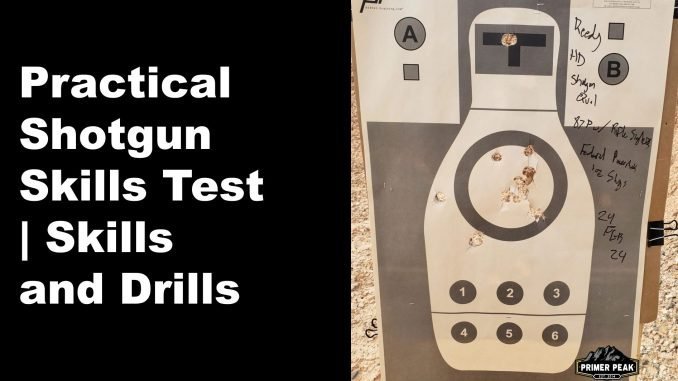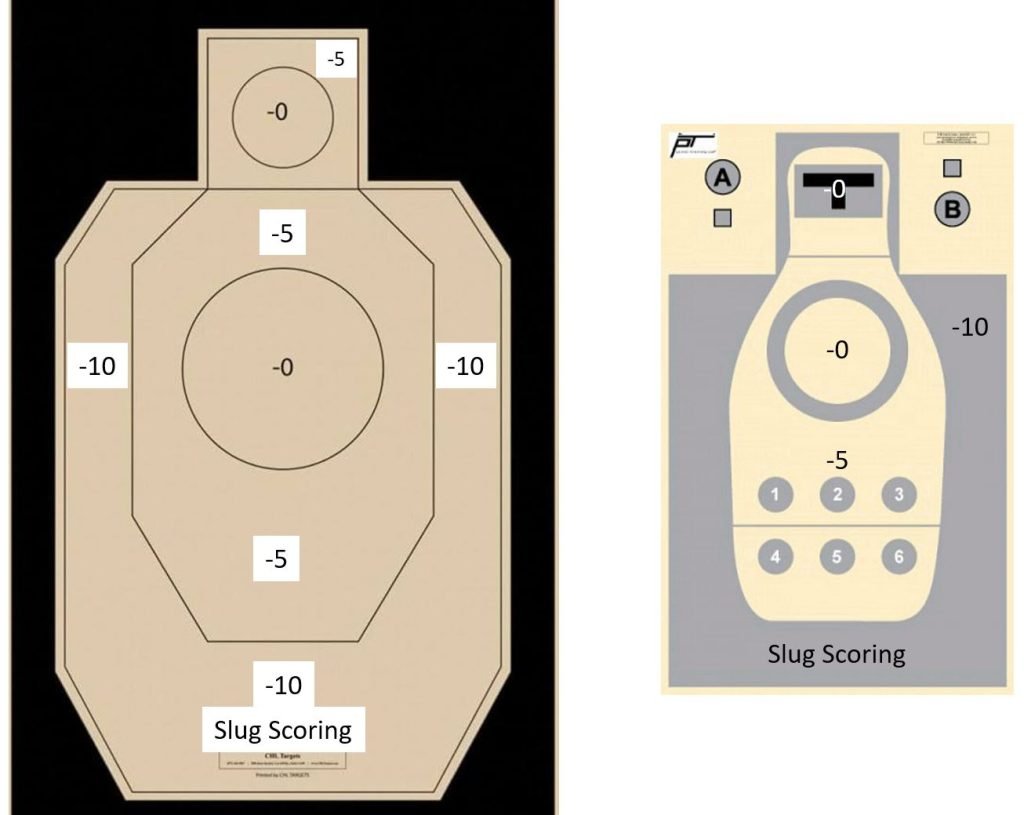
Nearly three years ago I came across the Lucky Gunner Home Defense Shotgun Skills Test. As someone who loves shotguns, but didn’t have many resources for courses of fire, I was ecstatic to see something like this. I ran the drill several times to varying levels of success with a few guns, and didn’t think much deeper. As time went by I began thinking about how I would change things to better suit some of my values as a shotgunner. Lucky Gunner gave us a great template, but I thought I might be able to do one a little better. Over the past few years I’ve slowly tweaked things until arriving at we have here today.
Setting up the Drill
This is a fairly straightforward course of fire. Shooters will need 10x rounds of either buckshot or slugs, ideally using whatever they typically load into their defensive shotgun. Stages do not call for specific loads, so shooters can load what they prefer. Movement is necessary for one stage, with details on application in the course of fire.
One target is required, something with dedicated chest and head scoring rings is needed, such as the RM-1 or IALEFI-Q. For my shooting I use a PT-Q, and have previously used IDPA silhouettes. A maximum of 25 yards, and a minimum of 3 yards will be necessary for this course of fire. I suggest using a cardboard target to ease scoring. When using a paper target, a cardboard backer will help to keep the target from blowing backwards during some stages.

All shooting will be conducted from low ready. There are no reloads in this course of fire. A shot timer will be required for a baseline of skill and to measure your progress. Scoring is the same regardless of action used (pump, semiautomatic, break, etc). Use of the safety is determined by the shooter. There are no handicaps for cruiser ready during the course of fire. I suggest using your real-world start condition at the beginning of each stage.
Scoring the Reedy Practical Shotgun Skills Test
There are 100 points possible for this course of fire. Projectiles landing off the silhouette is fail, and a reduction of ten points per projectile. Breaking par times is a fail. Shooters must achieve 80% score to be considered “passing”. Rounds inside the A/-0 scoring rings are given full value. Pellets landing outside the A/-0 are a reduction of 1 point per pellet. Slugs are valued at 10 points each. Slugs landing outside the A/-0 zones are a reduction of 5 points. Rounds breaking the line between scoring zones are awarded the higher value. Due to their large size, rounds in the D/-3 Zones of USPSA/IDPA silhouettes count as a miss.

No considerations are made for poor patterning buckshot versus tighter patterning ammunition. No considerations are made for different sizes of shot, such as 00, #1, #4, etc, with each pellet retaining full value despite the total number of pellets. There are no considerations are made for different chokes. Choose your load wisely, as it will have a direct impact on your score.
Par times are organized on a Novice/Intermediate/Advanced scale. These are not a pass/fail standard, but a way to measure growth.
Firing the Drill
All stages are shot from low ready unless otherwise noted, facing the target. Low ready is defined as having the shotgun shouldered, with the muzzle pointed just below the base of the target stand or simulated feet of the target, to avoid covering any portion of the target with the muzzle. Target area is the 8-inch chest circle unless otherwise noted. Guns should have a round chambered at the beginning of each stage unless otherwise noted. Shooters may begin at Cruiser Ready if desired, but no handicaps are provided. Safety position is user’s preference.
- Stage 1) 25 yards
- Fire 1x round. Par time is 2.5/1.5/1 seconds
- Stage 2) 15 Yards
- Fire 1x round. Par time is 1.75/1.25/0.75 seconds
- Stage 3) 10 Yards
- Fire 2x rounds. Par time is 3/2/1 seconds
- Stage 4) 7 Yards
- Fire 1x round. Par time is 1.5, 1.0, 0.5 seconds
- Stage 5) 5 Yards
- Shotgun in cruiser ready condition, with 3 rounds in the magazine. Start position is low ready. Cycle action and fire 3x rounds. Par time is 5/4/3 seconds
- Stage 6) 3 Yards
- Shotgun chambered, held compressed in short stock or armpit tuck position. Fire 1x round at body while compressed, take one step laterally, then fire 1x round at head from shouldered position. Par time is 3.5/2.5/1.5 seconds.
- If unable to short stock/armpit tuck, fire all rounds from shouldered position.
- If unable to step laterally, step backward. When unable to move on the line, remain stationary and annotate your time.
- Shotgun chambered, held compressed in short stock or armpit tuck position. Fire 1x round at body while compressed, take one step laterally, then fire 1x round at head from shouldered position. Par time is 3.5/2.5/1.5 seconds.
Notes for Success
I recommend scoring your target and recording your time between each stage. In my experience, this has made it easier to keep track of my hits, marking each impact with a sharpie or something similar. However this can significantly increase time commitments with larger numbers of shooters. Using slugs for this course will reduce the difficulty of scoring, but likely will not be representative of a buckshot pattern.
Cardboard targets are preferable to paper targets, as the paper quickly disintegrates, especially at closer ranges and can often be blown backwards on stages with multiple shots, which impacts accurate scoring.
My Scores on the Reedy Practical Shotgun Skills Test
I have shot variations of this course of fire several times during its development. Most recently I made an attempt using slugs to see how that compares to buckshot. As expected, not having to account for spread drastically improves scores and results in faster times. On multiple occasions I found myself making Advanced par times, or close to them. Typically I sit firmly in the Intermediate par times when using buckshot.

Some Differences
Being based on Lucky Gunner’s test, I want to clarify some of the changes made here.
First and foremost, we have differences in scoring. Rather than allowing for A/C zone hits to have full value, we’ve restricted that to just the A/-0 zone of our target. This is to create consistency across multiple types of firearms, as we would likely never give a C-Zone hit full value with a pistol. We’re driving accountability here, even with the scattergun. That starts with holding a high standard for performance.
Next, the maximum distance has been increased to 25 yards. We can frame this from the context of home defense. Sure, most homes don’t have an interior 25-yard shot, but when we start looking outward, that becomes more of a reality. There could be a threat in the street or in our backyard firing into our home that must be stopped. In my last house there was a hallway that stretched for about 20 yards from either end of the home. It’s certainly possible that we may have to make an extended range shot, and it’s up to us to know how our gun performs there.
Finally, there are some differences with round counts, reloads, par times, and start positions. In short, these changes come down to what I find more valuable in a course of fire. One goal I did have was keeping mine to 10 rounds, a clean two boxes of most buckshot or slugs. That was done to ease the burden on the shooter in times of ammunition droughts. I don’t think Chris or the team at Lucky Gunner is wrong with their test, I just want to work different skills. I still practice theirs from time to time due to those different skills, and you should too.
Final Thoughts on the Reedy Practical Shotgun Skills Test
There’s some bias here, but I think my Practical Shotgun Skills Test is a really solid course of fire. Some good skills are worked, and there is a definite path of progression in place with par times. Poor patterns are certainly punished, but that is a reality that we may have to face one day. I’ve run the course with a variety of guns, sighting systems, and loads, and good gear can make a major difference.
What do you think of the Reedy Practical Shotgun Skills Test? Give it a try for yourself and let us know your thoughts in the comments! While you’re at it, check out my Shotgun Diamond Drill for another challenge.
Special Thanks
I want to give another shout out to Nate over at That Shotgun Blog. Much like with my Shotgun Diamond Drill, Nate was a major source of assistance here. He ran through a few iterations of the course of fire at his own expense to provide feedback and another voice to ensure a better product made it to readers. Go check out his work, he’s one of the best shotgunners in the game!
Support My Work
If you made it this far, thanks for reading! Writing isn’t my full-time profession, and nearly everything I do comes out of my own pocket. Between ammunition, tuition, range fees and more, expenses add up fast. If you like what I have to offer, consider making a donation to my Patreon.
Every bit helps bring more work like this to you, and contributes to shortened timelines or more in-depth work on my part. You’ll also have more direct access to me, offering suggestions for future projects, looking behind the scenes, and getting early access to some content. You can find my Patreon >>HERE<<





3 Trackbacks / Pingbacks